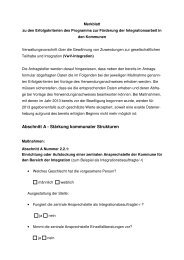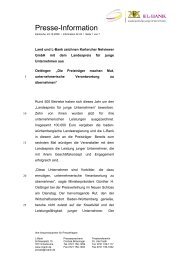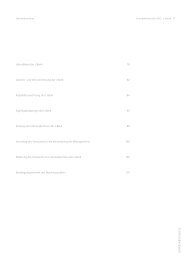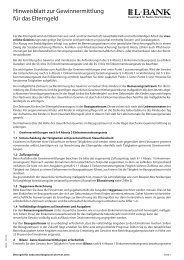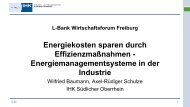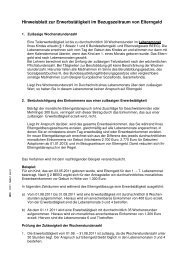Landeskreditbank Baden-Württemberg - L-Bank
Landeskreditbank Baden-Württemberg - L-Bank
Landeskreditbank Baden-Württemberg - L-Bank
Create successful ePaper yourself
Turn your PDF publications into a flip-book with our unique Google optimized e-Paper software.
Revenue Service (“IRS”). Additional rules applicable to Discount Debt Securities that are denominated in or<br />
determined by reference to a currency other than the U.S. dollar are described under “Foreign Currency Debt<br />
Securities” below. Notice will be given in the applicable prospectus supplement when the Issuer determines that<br />
a particular Debt Security will be a Discount Debt Security.<br />
For United States federal income tax purposes, original issue discount is the excess of the stated redemption<br />
price at maturity of a Debt Security over its issue price, if such excess equals or exceeds a de minimis amount<br />
(generally 0.25% of the Debt Security’s stated redemption price at maturity multiplied by the number of<br />
complete years to its maturity from its issue date or, in the case of a Debt Security providing for the payment of<br />
any amount other than qualified stated interest (as defined below) prior to maturity, multiplied by the weighted<br />
average maturity of such Debt Security). The issue price of each Debt Security in an issue of Debt Securities<br />
equals the first price at which a substantial amount of such Debt Securities has been sold (ignoring sales to bond<br />
houses, brokers, or similar persons or organizations acting in the capacity of underwriters, placement agents, or<br />
wholesalers). The stated redemption price at maturity of a Debt Security is the sum of all payments provided by<br />
the Debt Security other than “qualified stated interest” payments. The term “qualified stated interest” generally<br />
means stated interest that is unconditionally payable in cash or property (other than debt instruments of the<br />
issuer) at least annually at a single fixed rate (or a variable rate, in certain circumstances described below under<br />
“—Variable Debt Securities”). In addition, under the OID Regulations, if a Debt Security bears interest for one<br />
or more accrual periods at a rate below the rate applicable for the remaining term of such Debt Security (e.g.,<br />
Debt Securities with teaser rates or interest holidays), and if the greater of either the resulting foregone interest<br />
on such Debt Security or any “true” discount on such Debt Security (i.e., the excess of the Debt Security’s stated<br />
principal amount over its issue price) equals or exceeds a specified de minimis amount, then the stated interest on<br />
the Debt Security would be treated as original issue discount rather than qualified stated interest.<br />
Payments of qualified stated interest on a Debt Security are taxable to a U.S. Holder as ordinary interest<br />
income at the time such payments are accrued or are received in accordance with the U.S. Holder’s regular<br />
method of tax accounting. A U.S. Holder of a Discount Debt Security must include original issue discount in<br />
income as ordinary income for United States federal income tax purposes as it accrues under a constant yield<br />
method in advance of receipt of the cash payments attributable to such income, regardless of such U.S. Holder’s<br />
regular method of tax accounting. In general, the amount of original issue discount included in income by the<br />
initial U.S. Holder of a Discount Debt Security is the sum of the daily portions of original issue discount with<br />
respect to such Discount Debt Security for each day during the taxable year (or portion of the taxable year) on<br />
which the U.S. Holder held the Discount Debt Security. The daily portion of original issue discount on any<br />
Discount Debt Security is determined by allocating to each day in any accrual period a ratable portion of the<br />
original issue discount allocable to that accrual period. An accrual period may be of any length and the accrual<br />
periods may vary in length over the term of the Discount Debt Security, provided that each accrual period is no<br />
longer than one year and each scheduled payment of principal or interest occurs either on the first day or final<br />
day of an accrual period. The amount of original issue discount allocable to each accrual period is generally<br />
equal to the difference between (i) the product of the Discount Debt Security’s adjusted issue price at the<br />
beginning of such accrual period and its yield to maturity (determined on the basis of compounding at the close<br />
of each accrual period and appropriately adjusted to take into account the length of the particular accrual period)<br />
and (ii) the amount of any qualified stated interest payments allocable to such accrual period. The adjusted issue<br />
price of a Discount Debt Security at the beginning of any accrual period is the sum of the issue price of the<br />
Discount Debt Security plus the amount of original issue discount allocable to all prior accrual periods minus the<br />
amount of any prior payments on the Discount Debt Security that were not qualified stated interest payments.<br />
Under these rules, U.S. Holders generally will have to include in taxable income increasingly greater amounts of<br />
original issue discount in successive accrual periods.<br />
Variable Debt Securities. Under the OID Regulations, “Variable Debt Securities” are subject to special rules<br />
whereby a Variable Debt Security will qualify as a “variable rate debt instrument” if (a) its issue price does not<br />
exceed the total noncontingent principal payments due under the Variable Debt Security by more than an amount<br />
equal to the lesser of (x) 0.015 multiplied by the product of the total noncontingent principal payments and the<br />
70



